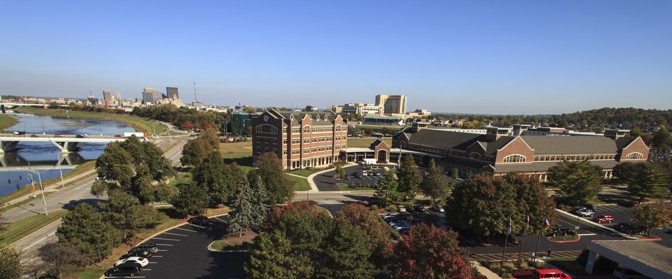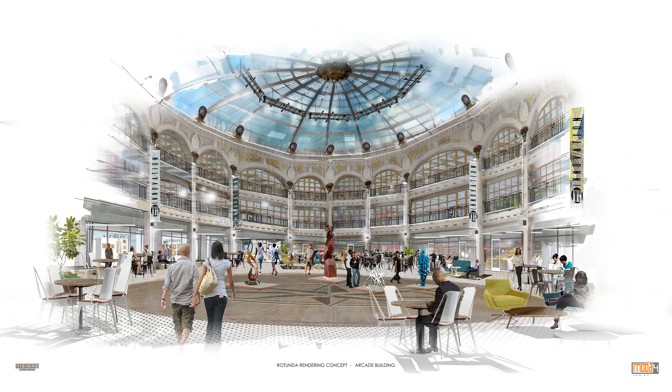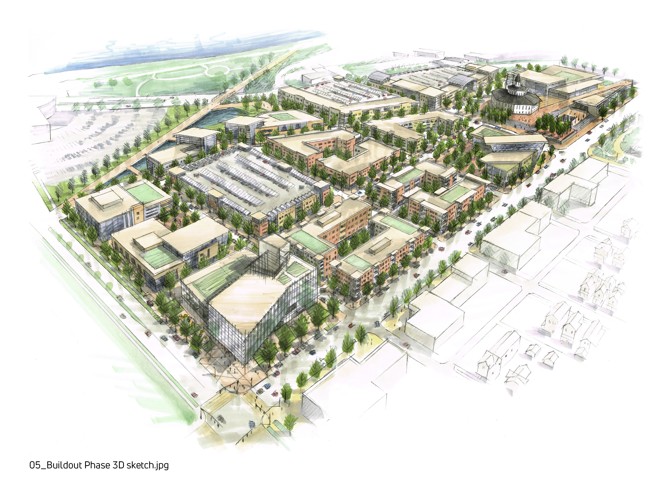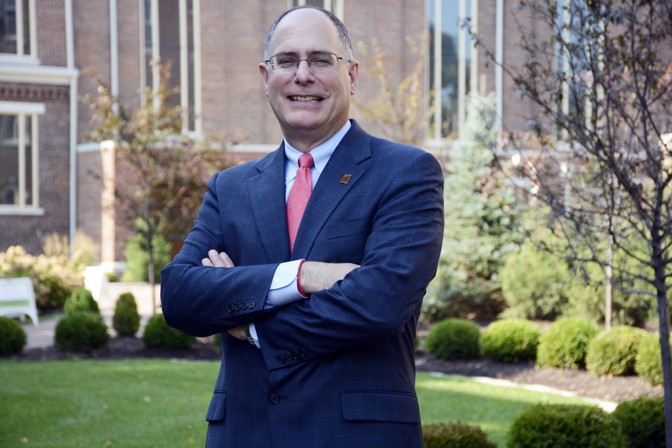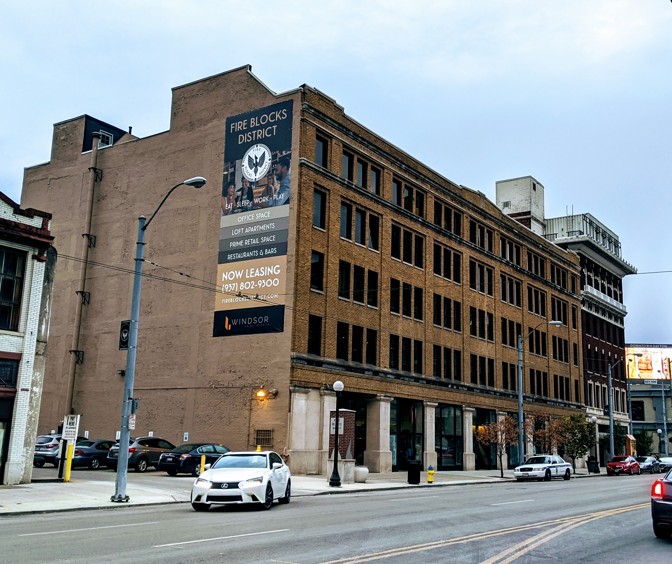It’s time for another report on Dayton, Ohio, subject of this introduction last month.
A century ago, Dayton was known mainly for the things it created, from the Wright Brothers’ airplanes to the cash registers used around the country and produced by Dayton’s home-grown National Cash Register corporation, later NCR.
Over the past generation Dayton has often been the dateline for stories about things older Rust Belt communities have lost. In Dayton’s case, these include a major GM assembly plant, whose closing two days before Christmas in 2008 was chronicled in the HBO documentary film The Last Truck, by local filmmakers Julia Reichert and Steve Bognar. A few months after GM’s departure, the city lost NCR itself, which in 2009 delivered the shocking news that it was moving its headquarters to Atlanta and abandoning the riverside office park in Dayton that it had built for itself back in the 1970s, during the heyday of the sprawling “office-campus” trend.
At the time of the move to Atlanta, some 1,250 NCR employees were working in Dayton, most within earshot of the imposing Deeds Carillon, built by one of the company’s early leaders and an all-around civic titan, Col. Edward Deeds. As the New York Times’ Dan Barry pointed out in an artfully acidic piece the year after the move, the Carillon remains even as other traces of NCR have vanished. Barry noted that the NCR executive who presided over the change, a controversial figure named Bill Nuti, had himself declined ever to shift his residence from New York to Dayton—and was prominently featured in the Atlanta press saying that the relocation out of Dayton was “great for NCR.” Perhaps so, but for Dayton it represented the loss of its last remaining Fortune 500-company headquarters and a large number of high-end jobs.
But, as noted in this previous post, things move on. The closings weren’t the end—for the physical structures that GM and NCR has abandoned, or for the town. After The Last Truck, Julia Reichert and Steve Bognar made a celebrated followup Netflix documentary, American Factory, about the Chinese glass-making Fuyao that has set up operations in GMs old plant. NCR’s expansive former office-park suite of structures near the Carillon are now occupied by research centers for GE and the electronics company Emerson, Cox Media’s broadcast and print operations, a variety of others firms, and many operations of the University of Dayton, located nearby. “The footprint NCR left in Dayton is large,” Ty Greenlees, of the Dayton Daily News, wrote last year, in an updated look at the site NCR had left behind. “But many in the community saw opportunity.”
Today’s subject is how one of the city’s major institutions, the University of Dayton, has decided to throw itself all-in, to the effort to find new opportunities in and for the town. (Another of these institutions, Sinclair Community College, is similarly all-in on the Dayton-renewal effort. More about what Sinclair is doing in an upcoming report.)
“The city’s name is in our name,” Eric Spina, an engineer who came from Syracuse University to become president of the University of Dayton three years ago, told me when I visited the town last month. “The health and vibrancy of the city, especially of the urban core, are central to our ability to exist—to attract the best faculty and staff, to convince parents that this is where they want to send their kids. So bringing vitality to this city and region really is an existential question for us.”
This past spring, I reported from Muncie, Indiana, where Ball State University—a large, public institution—has taken responsibility for the city’s troubled K-12 public schools. To the best of my knowledge—and that of the Ball State authorities—this is the first time a U.S. public university has directly run a community’s schools. The Ball State move is a particularly clear-cut example of a trend that Deb Fallows and I have seen around the country: The commitment by four-year and research universities, which might traditionally have tried to wall themselves off from urban problems through a widening town-and-gown separation, instead to view their future as linked to the community’s.
The University of Dayton is a private, Catholic, relatively prosperous research institution, founded by the Marianist (Society of Mary) order of the church. Geographically, its lovely main campus is set apart from downtown Dayton and its struggles—across the boundary of an interstate, miles from the main manufacturing centers, in the sylvan riverside area next to where NCR also chose to build its campus.
One strategy for universities like this, in towns like this, would be to say: Hey, that’s them, too bad for their problems, but come see how nice life can be on our sheltered campus. Another approach, of which we’ve seen more and more examples, is for university leaders to say: This is us, we rise or fall together, let us prepare our students for their broad global possibilities by teaching them responsibility for where we are now.
What are illustrations of the University of Dayton’s investment in the city? I mentioned last month Eric Spina’s speech at a Dayton-renewal conference where he said that the university, as an “anchor institution” of the community, was there to stay. “We’re not moving to Mexico City,” he said. “We’re not moving to Atlanta,” an NCR reference that everyone in the audience understood.
In practical terms this means several physical commitments:
One is the university’s investment in the $90-million-plus renovation of the Dayton Arcade—a century ago the focus of downtown commerce, but for the past generation another derelict structure. (I’ll have more to say about this project, and the downtown as a whole, in another report.)
Another is its financial and reputational commitment to the “onMain” project, designed to create “Dayton’s Imagination Zone.” The project will involve development of a long, 38-acre tract of mostly undeveloped land long occupied by the Montgomery County Fair. It conveniently runs the distance from downtown Dayton to the university district—and from the university to the river.
“This is not a 5-year project, or 10, or 20, or 30,” Spina told me. “This is a 150-year investment. How often do you get 38 uncontaminated acres in the middle of a city? Not very frequently, and we are all determined to do this right.”
Doing it right, in his view, would involve a sustained investment in mixed-income housing, locally focused retail, parks and amenities, and other aspects of the modern urban ideal. When completed, it is meant to foster a connection rather than a separation between town and gown—and explicitly a closer connection between Dayton’s black and white communities, for which the Miami River has been a historic dividing line.
Why bother? I asked Spina why development of Dayton-the-city should be part of his franchise as leader of Dayton-the-private-university. He told me his views on that topic—and also about what people misunderstand about a “declining” midwestern city like this.
On the university, he said that its Marianist heritage predisposed its students and faculty toward community involvement. But beyond that, he said, “I see two primary reasons for deeper engagement.”
One was “our fiduciary responsibility to students—making sure that they have the best possible education.” Rigor in the classrooms is supposed to be taken for granted. But, he said, “I believe that education is optimized if we get students out of their bubble.” Through engagement in the community’s struggles, “they may come to understand that they aren’t going to solve any of these problems. They are there to contribute—their knowledge, their skill, themselves—to a team that can address big issues. That is learning to be a leader, in the Marianist way of life.”
The other motivating force, he said, was the school’s like-it-or-not connection to the city’s progress and reputation. “We are here,” he said. “We employ more than 3,000 people. We have, with grad students and undergrads, more than 11,000 students.”
“We own homes here. We spend money here. We recreate here. We have an extraordinary research institute, which has grown from 400 employees to about 600. We want this region to be successful, and we believe we can contribute to that. In this day and age, when fewer institutions seem to have both a longer vision and a sense of connectivity to the local and and a commitment to the public good, I think we have to remember that universities should be committed to the public good.”
The other topic I asked Eric Spina about was the outlook and self-image of Dayton. When national media go there, it’s usually for a “Rust Belt city in crisis” story, or for a followup to the Oregon District shootings in downtown Dayton this past summer. What was it like to lead a major institution there, day in and day out?
“We can argue about whether downtown Dayton is at the [positive] tipping point or not,” he said, referring to the blocks around the arcade project. “I do think a few more things need to happen. But all of a sudden, there are successful developers from outside the area who have begun projects here. All of a sudden, many people are living downtown, and even in the suburbs you have this awareness that there are free concerts, restaurants, arts, other interesting things going on downtown.”
I asked him what he said to prospective faculty members or students, about deciding to commit to this town. “First I say, forget what you’ve heard about the ‘rust and decline.’ Think about the people. The people here are highly collaborative. They work together and they get things done.” He gave the example of bigger-city arts organizations, where the ballet and the symphony and the opera talk about joint efforts—but feud, compete, and don’t move past talk. “Here we have the Dayton Performing Arts Alliance,” with combined calendars and ticket sales for a range of arts organization. “That’s one illustration that speaks to the heart and soul of the community, where the dominant culture is practical-minded, toward getting things done. It’s a place where there are collaborators, and the quality of life is high.”
Five years ago I wrote about the unofficial and mostly joking civic motto for the fast-growing city of Greenville, South Carolina: “Greenville, are you kidding?” When a company transferred a family to Greenville from a more “glamorous” location, the first reaction was typically, “Are you kidding?” But as the city’s mayor, Knox White, told us, “They wouldn’t come here—until they came here, kicking and screaming, and the next thing you know, they’d bought a house.” (The rapid in-migration to Greenville makes this more than just a boosterish claim.)
The Dayton version of this joke-motto is that the city is a “two-cry” place, a term particularly widespread among the military families transferred into and away from the adjoining, huge Wright-Patterson Air Force Base. Many people I met told me about this concept, including Eric Spina: When he was in his final interview with the university’s presidential-selection committee, his wife, Karen, went to lunch with some Dayton residents. “They told her that Dayton was a ‘two-cry’ town,” Spina said. “She asked, What do you mean? And they said: You cry when you hear that you have to move to Dayton. Then you cry when you hear you have to leave.”
Is this the view of someone with an interest in putting the community in the best light? Of course. Does it fully represent all the perspectives, heartbreaks, and divisions in a still-troubled region? Of course not. But this perspective is different enough from the standard media view of places like Dayton, and also representative enough of the institutional innovation we’ve seen from central Oregon to southern Georgia, to be worth attention.
Next up: another important and nationally significant part of Dayton’s educational mix.
Source link
 Black America Breaking News for the African American Community
Black America Breaking News for the African American Community

